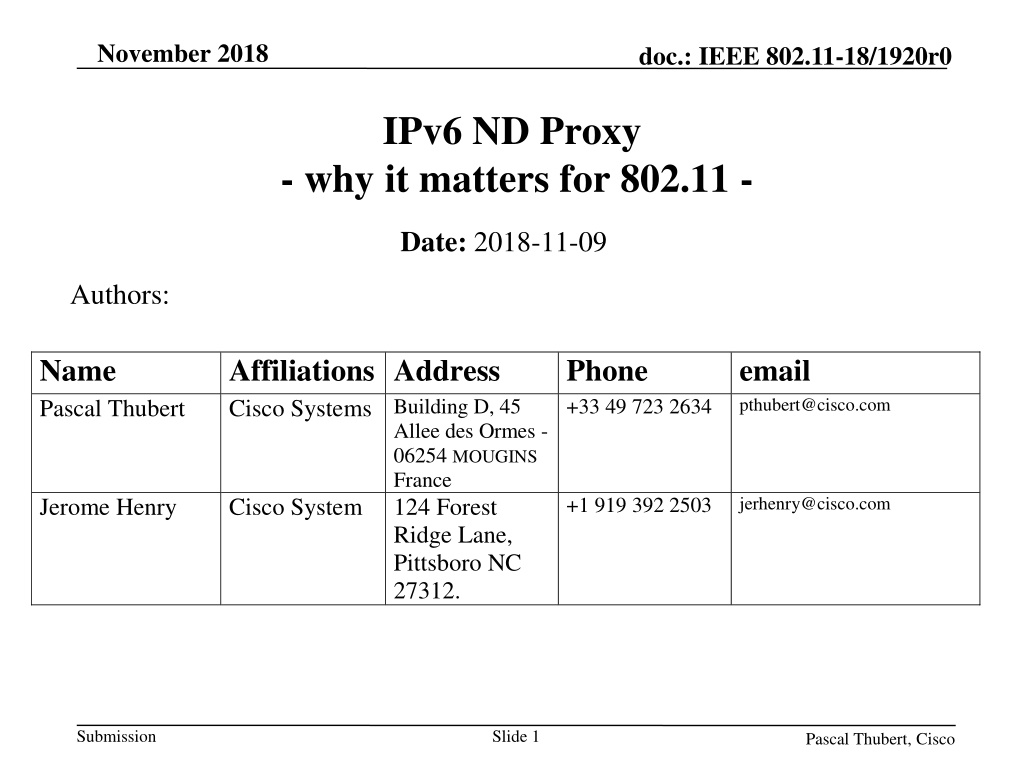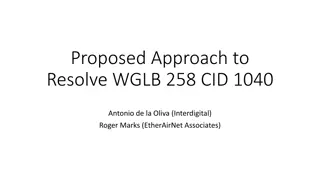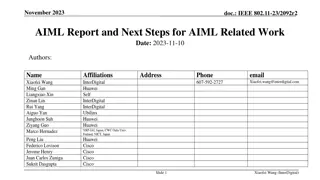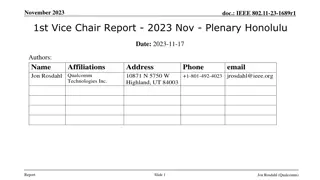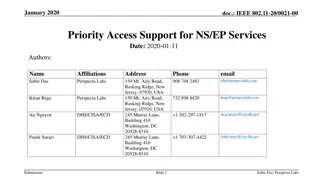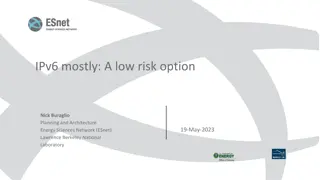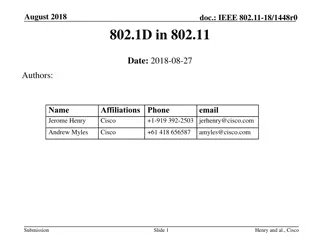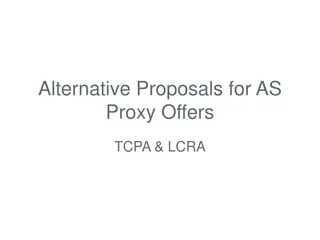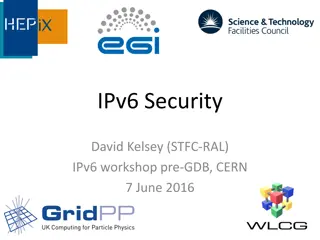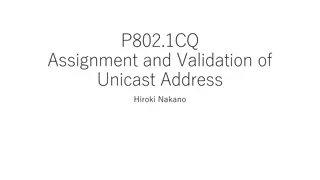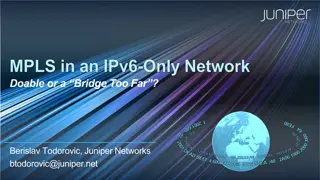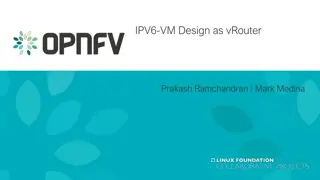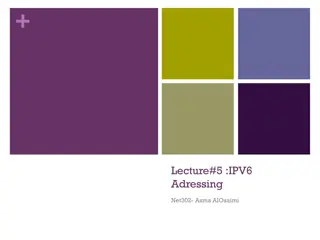IPv6 ND Proxy in IEEE 802.11: Why It Matters
This submission discusses the significance of implementing an IPv6 Neighbor Discovery (ND) Proxy in IEEE 802.11 networks. It introduces new functions and variations for the proxy service, addressing challenges such as multicast scalability, address uniqueness, and broadcast congestion. The document highlights the need for broadcast domain separation, reliable broadcasting, and efficient multicast handling in wireless environments. References to relevant IETF drafts and the role of RFC 6775 in resolving issues related to Proxy and routing services are also provided.
Download Presentation

Please find below an Image/Link to download the presentation.
The content on the website is provided AS IS for your information and personal use only. It may not be sold, licensed, or shared on other websites without obtaining consent from the author.If you encounter any issues during the download, it is possible that the publisher has removed the file from their server.
You are allowed to download the files provided on this website for personal or commercial use, subject to the condition that they are used lawfully. All files are the property of their respective owners.
The content on the website is provided AS IS for your information and personal use only. It may not be sold, licensed, or shared on other websites without obtaining consent from the author.
E N D
Presentation Transcript
November 2018 doc.: IEEE 802.11-18/1920r0 IPv6 ND Proxy - why it matters for 802.11 - Date: 2018-11-09 Authors: Name Pascal Thubert Affiliations Address Cisco Systems Building D, 45 Phone +33 49 723 2634 email pthubert@cisco.com Allee des Ormes - 06254 MOUGINS France 124 Forest Ridge Lane, Pittsboro NC 27312. +1 919 392 2503 Jerome Henry Cisco System jerhenry@cisco.com Submission Slide 1 Pascal Thubert, Cisco
doc.: IEEE 802.11-18/1920r0 Abstract This submission indicates a new IETF 802.11 WMN STA Proxy IPv6 Neighbor Discovery Service function This submission also proposes 1 variations for the implementation of this proxy function, a pure routing version that does not leak the MAC addresses from the wireless side, and a L3 bridging version whereby the proxy advertises the IPv6 address of the STA together with its MAC address. reference for the Submission Slide 2 Pascal Thubert, Cisco
November 2018 doc.: IEEE 802.11-18/1920r0 IPv6 ND proxy references https://datatracker.ietf.org/doc/draft-ietf-6lo-rfc6775-update/ https://datatracker.ietf.org/doc/draft-ietf-6lo-backbone-router/ https://datatracker.ietf.org/doc/draft-ietf-6lo-ap-nd/ Pascal Thubert Submission Pascal Thubert, Cisco
November 2018 doc.: IEEE 802.11-18/1920r0 Unmet expectations Solicited node multicast requires highly scalable L2 multicast IEEE does not provide it => turns everything into broadcast IPv6 ND appears to work with broadcast on 802.1 fabrics up to some scale ~10K nodes IPv6 ND requires reliable and cheap broadcast Radios do not provide that => conserving 802.1 properties over wireless is illusory RFC 4862 cannot operate as designed on wireless Address uniqueness is an unguaranteed side effect of entropy 802.11 expects proxy operation and broadcast domain separation 802.11 provides a registration and proxy bridging at L2 Requires the same at L3, which does not exist (NULL ref to ND proxy) Implementations provide proprietary techniques based on snooping (SAVI) => widely imperfect RFC 6775 solves the problem for DAD in one BSS This update enables a registration for proxy and routing services across the ESS Submission Pascal Thubert, Cisco
November 2018 doc.: IEEE 802.11-18/1920r0 Use AND implementation of mCast in IPv6 ND 1. IPv6 Discovery protocols use multicast flooding Assuming a lower layer multicast support Not just IPv6 NDP but also mDNS, etc 2. Layer-2 destination set to 3333XXXXXXXX 3. Layer-2 fabric handles as broadcast (all nodes) 4. Broadcast clogs the wireless access at low access speed (typically 1Mbps) on all APs around the fabric 5.Broadcast self interferes on attached wireless mesh and drains the batteries on all nodes Submission Pascal Thubert, Cisco
November 2018 doc.: IEEE 802.11-18/1920r0 Flooding for mobility IPv6 STA moves from AP within ESS: 1. MAC address reachability flooded over L2 switch fabric 2. Device sends RS to all routers link scope mcast 3. Router answers RA (u or m) 4. Device sends mcast NS DAD to revalidate its address(es) 5. Device sends mcast NA(O) An ND proxy, aka backbone router, limits the broadcast domain to the backbone Submission Pascal Thubert, Cisco
November 2018 doc.: IEEE 802.11-18/1920r0 flooding for Neighbor Discovery Packet comes in for 2001:db8::A1 1. Router looks up ND cache (say this is a cache miss) 2. Router sends NS multicast to solicited-node multicast @; here that is 3333 FF00 00A1 1. Targets answers unicast NA 2. Target revalidates ND cache for the router, usually unicast 3. Router creates ND cache entry 6TiSCH proxies at the backbone router on behalf of device Submission Pascal Thubert, Cisco
NOVEMBER 2018 doc.: IEEE 802.11-18/1920r0 ND PROXY DRAFTS Submission Pascal Thubert, Cisco
November 2018 doc.: IEEE 802.11-18/1920r0 In a nutshell Provide for draft-thubert-6lo-rfc6775-update-reqs draft-ietf-6lo-rfc6775-update (RFC-to-be 8505) The Layer-3 equivalent to the wireless association by a STA Enables registration to both ND proxy and IPv6 routing services draft-ietf-6lo-ap-nd Protects addresses against theft (Crypto ID in registration) draft-ietf-6lo-backbone-router Federates 6lo meshes over a high speed backbone The Layer-3 equivalent to the bridging operation by an AP Submission Pascal Thubert, Cisco
doc.: IEEE 802.11-18/1920r0 RFC 6775 UPDATE (RFC-TO-BE 8505) P.Thubert, E. Nordmark, S. Chakrabarti, C. Perkins Submission Pascal Thubert, Cisco
November 2018 doc.: IEEE 802.11-18/1920r0 Router/S erver erver Routerver Router/ver Router Router/S Router/S erver 6LBR STA/6LN 6BBR AP/6LR 802.11 Bridged Ethernet RFC 6775 RFC 4861/4862 RA (u|mcast) PIO MTU RA (u|mcast) PIO MTU SLLA Submission Pascal Thubert, Cisco
November 2018 doc.: IEEE 802.11-18/1920r0 6LBR STA/6LN 6BBR AP/6LR 802.11 RFC-to-be 8505 Create binding state NS (ARO) SRC = 6LN LL ** DST = 6BBR LL ** TGT = 6LN SLLA = 6LN UID = ROVR TID included ** link local * Can be Anycast Submission Pascal Thubert, Cisco
November 2018 doc.: IEEE 802.11-18/1920r0 6BBR AP/6LR 6LBR STA/6LN 802.11 RFC-to-be 8505 NA (ARO) SRC = 6BBR LL ** DST = 6LN LL ** TGT = 6LN TLLA = 6LN UID = ROVR TID included ** link local Submission Pascal Thubert, Cisco
November 2018 doc.: IEEE 802.11-18/1920r0 Status of the document IANA steps https://www.iana.org/assignments/icmpv6-parameters/icmpv6- parameters.xhtml#icmpv6-parameters-codes-type-157-code-suffix Done RFC Editor disambiguations and edition RFC Editor state : RFC-EDITOR * * Awaiting final validation by authors, 2 of them pending Submission Pascal Thubert, Cisco
doc.: IEEE 802.11-18/1920r0 DRAFT-IETF-6LO-AP-ND P. Thubert, B. Sarikaya, M Sethi, R. Struik Submission Pascal Thubert, Cisco
November 2018 doc.: IEEE 802.11-18/1920r0 Expectations First come first Serve address registration First registration for an address owns that address till it releases it The network prevents hijacking Source address validation Address must be topologically correct Source of the packet owns the source address First Hop Security only? Proxy ownership and routing advertisements not protected yet Submission Pascal Thubert, Cisco
November 2018 doc.: IEEE 802.11-18/1920r0 LP Node STA/6LN 6LR AP/6LR 802.11 AP-ND NS (EARO(ROVR=Crypto-ID)) NA (EARO(status=Validation Requested), Nonce) NS (EARO, CIPO*, Nonce and NDPSO**) NA (EARO(status=0)) * Crypto-ID Parameters Option ** NDP Signature Option Submission Pascal Thubert, Cisco
November 2018 doc.: IEEE 802.11-18/1920r0 Recent changes Published -08 Ren Struik joined as contributing author Updated the computation of the Crypto-ID Crypto-Id in EARO is a truncated hash of the node's public-key Digital signature (SHA-256/NIST P-256 or SHA-512/EdDSA) in NDPSO is executed on additional material (nonces, etc , see updated section 6.2) for proof of ownership of the private key Uses both nonces from the 6LN and 6LR Removed SHA-256 for EdCSA to comply with RFC 8032. Submission Pascal Thubert, Cisco
doc.: IEEE 802.11-18/1920r0 DRAFT-IETF-6LO- BACKBONE-ROUTER P. Thubert Submission Pascal Thubert, Cisco
November 2018 doc.: IEEE 802.11-18/1920r0 Unmet expectations Scale an IOT subnet to the tens of thousands With device mobility (no renumbering) Controlled Latency and higher Reliability using a backbone Deterministic Address presence Route towards the latest location of an address Remove stale addresses Submission Pascal Thubert, Cisco
November 2018 doc.: IEEE 802.11-18/1920r0 Router/Ser ver ver AP/6BB AP/6BBR Router/S erver erver Router/Ser Router/Ser Router/S Router/S erver ver 6LBR STA/6LN 6BBR R 802.11 Bridged Ethernet Backbone router RFC-to-be 8505 Create binding state Create proxy state NS (ARO) SRC = 6LN LL ** DST = 6BBR LL ** TGT = 6LN SLLA = 6LN UID = OVR TID included NS DAD (ARO) SRC = UNSPEC DST = SNMA TGT = 6LN UID = ROVR TID included * Omitted in general ** link local * Can be Anycast Submission Pascal Thubert, Cisco
November 2018 doc.: IEEE 802.11-18/1920r0 Router/Ser ver ver AP/ Router/S erver erver Router/Ser Router/ Router/S Router/S erver Server 6LBR STA/6LN AP/6BBR 6BBR 6BBR 802.11 Bridged Ethernet Backbone router RFC-to-be 8505 DAD time out NA (O) * NA (ARO) SRC = 6BBR LL ** DST = SNMA TLLA = 2 modes TGT = 6LN SRC = 6BBR LL ** DST = 6LN LL ** TGT = 6LN TLLA = 6LN UID = ROVR TID included * Omitted in general ** link local Submission Pascal Thubert, Cisco
November 2018 doc.: IEEE 802.11-18/1920r0 Router/Ser ver ver Router/S erver erver Router/Ser Router/ Router/S Router/S erver Server 6LBR STA/6LN 6BBR AP/6BBR 802.11 Bridged Ethernet Backbone router RFC-to-be 8505 Proxy NS (EARO) NA (EARO) NS lookup NA (~Override) Packet Submission Pascal Thubert, Cisco
doc.: IEEE 802.11-18/1920r0 6BBR Status Quite Stable, no recent change WGLC is needed to make final progress Submission Pascal Thubert, Cisco
doc.: IEEE 802.11-18/1920r0 Resulting flows Submission Pascal Thubert, Cisco
November 2018 doc.: IEEE 802.11-18/1920r0 Initial time Routers within subnet have a connected route installed over the subnet backbone. PCE probably has a static address in which case it also has a connected route Connected Route to subnet Wireless Domain Submission Pascal Thubert, Cisco
November 2018 doc.: IEEE 802.11-18/1920r0 First advertisements from GW (RA, IGP, RPL) Gateway to the outside participate to some IGP with external network and attracts all extra-subnet traffic via protocols over the backbone Default Route In RIB Wireless Wireless Wireless Wireless Wireless Domain Domain Domain Domain Domain Submission Pascal Thubert, Cisco
November 2018 doc.: IEEE 802.11-18/1920r0 IPv6 ND Registration to 6LR and 6LBR Directly upon NS(ARO) or indirectly upon DAR message, the backbone router performs DAD on behalf of the wireless device. NS DAD (ARO) DAD NS (ARO) DAR Wireless Domain Submission Pascal Thubert, Cisco
November 2018 doc.: IEEE 802.11-18/1920r0 IPv6 ND Registration and Proxy for NS ARO NA(ARO) or DAC message carry succeful completion if DAD times out. NA(Override) is optional to clean up ND cache stale states, e.g. if node moved. Optional NA(O) NA (ARO ) DAC Wireless Domain Submission Pascal Thubert, Cisco
November 2018 doc.: IEEE 802.11-18/1920r0 IPv6 ND Proxy for RPL The BR maintains a route to the WSN node for the DAO Lifetime over instance VRF. VFR may be mapped onto a VLAN on the backbone. Optional NA(O) RPL DAO Host Route Wireless Domain Submission Pascal Thubert, Cisco
November 2018 doc.: IEEE 802.11-18/1920r0 RPL over the backbone The BBR maintains a route to the WSN node for the DAO Lifetime over instance VRF that is continued with RPL over backbone. RPL DAO RPL DAO Host Route Wireless Domain Submission Pascal Thubert, Cisco
November 2018 doc.: IEEE 802.11-18/1920r0 Duplication DAD option has: Unique ID TID (SeqNum) Defend with NA if: Different OUID Newer TID NS DAD (ARO) NA (ARO) NS (ARO) Wireless Domain Submission Pascal Thubert, Cisco
November 2018 doc.: IEEE 802.11-18/1920r0 Duplication (2) DAD option has: Unique ID TID (SeqNum) Defend with NA if: Different OUID Newer TID DAD NA (ARO) DAR Wireless Domain Submission Pascal Thubert, Cisco
November 2018 doc.: IEEE 802.11-18/1920r0 Mobility DAD option has: Unique ID TID (SeqNum) Defend with NA if: Different OUID Newer TID Optional NA(ARO NA (ARO) with older TID (loses) ) RPL DAO Host Route Wireless Domain Submission Pascal Thubert, Cisco
November 2018 doc.: IEEE 802.11-18/1920r0 Resolution NA ARO option has: Unique ID TID (SeqNum) NS lookup NA (ARO) Packet Wireless Domain Submission Pascal Thubert, Cisco
November 2018 doc.: IEEE 802.11-18/1920r0 Resolution (2) Mixed mode ND BBR proxying over the backbone NS lookup NA (ARO) Pack et Wireless Domain Submission Pascal Thubert, Cisco
doc.: IEEE 802.11-18/1920r0 Conclusion Proxy ND Service for IPv6 is complex; a real specification from the IETF was missing so far and the description in 802.11 was very high level The IETF is finally producing a specification for IPv6 ND proxy; 802.11 might consider adding a reference to that specification as the recommended IPv6 ND proxy technique Additionally, as 802.11 11.22.14 mentions a Layer 3 function, 802.11 might consider integrating the routing proxy function as one of the accepted ND proxy modes in addition to the bridging proxy. Submission Pascal Thubert, Cisco
